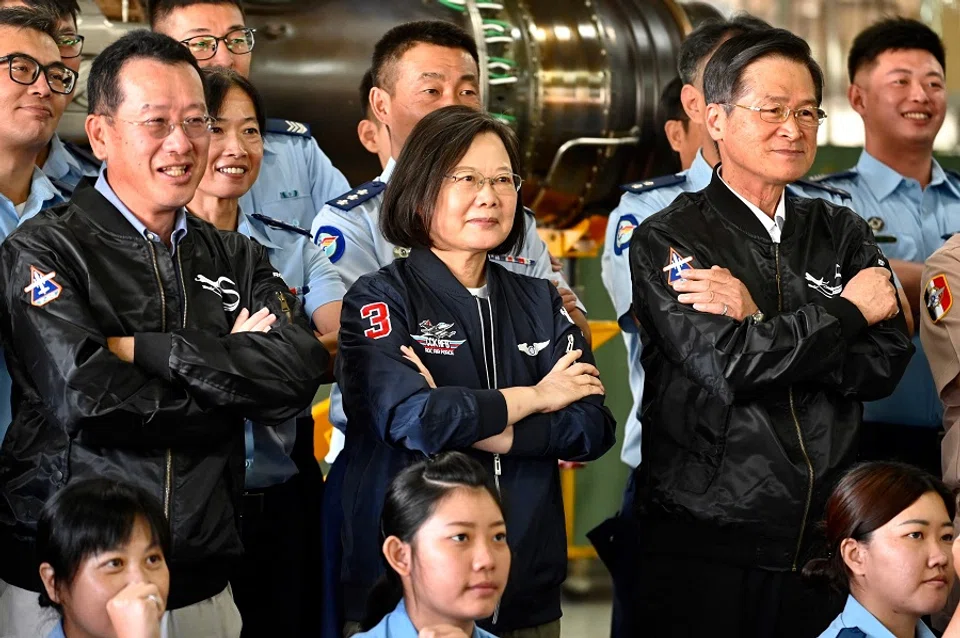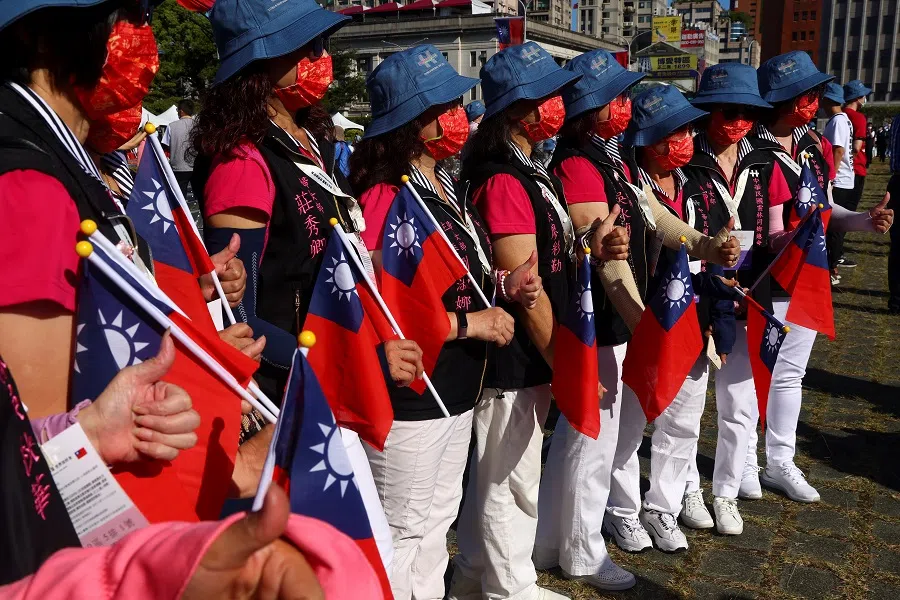How the 1992 Consensus could save cross-strait relations
Liu Chin-tsai notes that cross-strait relations are getting more volatile, with calls for armed reunification getting louder. He suggests that the crux of the matter lies in the DPP not acknowledging the 1992 Consensus, which is seen by mainland China as the "magic fulcrum" offering a structural framework and stability for cross-straits talks to take place. However, is it too late for the DPP to adjust its rhetoric and get cross-strait relations back on track?

In her Double Tenth Day speech, Taiwan President Tsai Ing-wen of the Democratic Progressive Party (DPP) discussed the threat of mainland China's frequent incursions into Taiwan's air defence identification zone (ADIZ), and asserted that regional order was "being challenged in the South and East China Seas" as a result.
She added that Taiwan was experiencing the "routinisation of Chinese military activity" in Taiwan's southwestern ADIZ, with mainland China flying a record 56 warplanes into the ADIZ in a single day, which seriously affected Taiwan's national and flight security.
Mainland China's increasingly frequent military drills and aerial incursions near Taiwan does not back up Tsai's previous assertions that Taiwan's non-provocative and non-aggressive stance has prevented serious conflicts between both sides of the Taiwan Strait.
In the words of Taiwan Defence Minister Chiu Kuo-cheng, the cross-strait situation is at the "most serious moment in my [his] 40 years of military service". He even warned that the mainland would have the ability to launch a "full-scale invasion" of Taiwan by 2025. Tsai also warned Beijing authorities to be "sure to exercise restraint and avoid actions that could spark a fire".

At the same time, the US said that the mainland's "provocative military activity" around Taiwan "undermines regional peace and stability". The New York Times reported, "As such confrontations intensify, the balance of power around Taiwan is fundamentally shifting, pushing a decades-long impasse over its future into a dangerous new phase."
Because Taiwan is at the core of the discord between the US and the mainland amid intense China-US competition, the possibility of a military confrontation between both sides of the Taiwan Strait is increasing. Indeed, be it the Beijing authorities or mainland Chinese society, calls for a reunification by force instead of peaceful reunification are getting louder.
As Taiwan's president, Tsai's ability to safeguard its sovereignty in a manner that is neither servile nor overbearing is indeed praiseworthy.
Despite Tsai's declaration that Taiwan would demonstrate its determination to defend itself and that it would maintain regional peace and stability, mainland China's military drills and aerial incursions have not ceased. Instead, the latter's actions have only increased in scale and frequency.

In her Double Tenth Day speech, Tsai also reiterated that Taiwan would not act rashly, but there should be "absolutely no illusions" of the Taiwanese bowing to pressure. There would also be no change to Taiwan's position on cross-strait relations, meaning that neither its goodwill nor its commitments would change, she asserted.
Tsai added that Taiwan would do its best to "prevent the status quo from being unilaterally altered". She also emphasised that "resolving cross-strait differences" required the two sides of the strait to "engage in dialogue on the basis of parity".
Tsai's political messaging seems comprehensive, reasonable, and powerful. As Taiwan's president, Tsai's ability to safeguard its sovereignty in a manner that is neither servile nor overbearing is indeed praiseworthy.
However, this does not mean that the core issue of cross-strait tensions has been addressed. It can even be said that tensions have continued to escalate precisely due to a "broken" fundamental national policy.
Reunification aim never in doubt
The cross-strait policy of the Republic of China (ROC) has always been one that pursues reunification, as is the case with amendments made to the ROC Constitution and the Act Governing Relations between the People of the Taiwan Area and the Mainland Area.
The former makes clear that the constitution was amended to "meet the requisites of the nation prior to national unification", while the latter clearly defines mainland China and Taiwan as "one country, two areas", positioning both sides of the Taiwan Strait as the "mainland area" and the "Taiwan area", not the "Republic of China" and the "People's Republic of China" based on the "two states" theory.
Be it the "one China" principle that was adopted in the era of the two Chiangs (Chiang Kai-shek and Chiang Ching-kuo), the battle for Chinese representation at the UN, Chiang Kai-shek's "30% military, 70% politics" policy of "recovering the mainland", or the formation of the Grand Alliance for China's Reunification under the Three Principles of the People, the quest for reunification was never questioned.
In the early days of former Taiwan President Lee Teng-hui's rule, he also claimed to adopt the one-China principle, where "one China" referred to the ROC. Despite the fact that he later proposed the concepts of "one country, two areas", "two equal political entities", "one country, two governments", "two Chinas", or even "special state-to-state relations", they all pointed to the fact that "one China = Republic of China + People's Republic of China" and that a strong "one China" element was maintained.

Even when Chen Shui-bian, former Taiwan president from the DPP, ruled and proposed the "Four Nos, one without" (would not declare Taiwan independence; would not change the national title; would not push for the "state-to-state" formulation in the constitution; would not promote a referendum on reunification or independence; and no abolition of the National Unification Council or the National Unification Guidelines) pledge, the "cross-strait political integration theory", and the "future one China" theory, the element of "one China" was retained.
The vicious cycle of increasing hostility and tense relations started with the DPP not acknowledging the 1992 Consensus, followed by the mainland China authorities taking retaliatory and suppressive military and diplomatic action...
DPP and 1992 Consensus misstep?
But under Tsai, despite claiming to handle cross-strait affairs in line with the ROC constitution and the Act Governing Relations between the People of the Taiwan Area and the Mainland Area, the government has never acknowledged that both sides are currently run separately as "one country, two areas" prior to reunification, or that Taiwan would not address the "mainland area" as "China" or the "People's Republic of China". Instead, the DPP government has talked about both sides being "neighbouring countries", which goes against the constitution and the legal definition of cross-strait relations.
And during the KMT's time in office, it abided by the 1992 Consensus, and emphasised finding common ground while preserving differences under the one-China principle - the idea of different interpretations of the one-China principle (一中各表). While the mainland China authorities said that the 1992 Consensus embodied the spirit of the "one-China principle" and did not publicly acknowledge "different interpretations of the one-China principle", dialogues and negotiations took place, and 23 agreements were signed.

The vicious cycle of increasing hostility and tense relations started with the DPP not acknowledging the 1992 Consensus, followed by the mainland China authorities taking retaliatory and suppressive military and diplomatic action, leading to public sentiment in mainland China going from "opposing Taiwan independence" to "opposing Taiwan", while public sentiment in Taiwan went from "anti-CCP" to "anti-China". Each side took unilateral tit-for-tat action and did not manage their differences, allowing the conflict to grow.
After Tsai took office, while US-Taiwan and Japan-Taiwan relations were closer than ever, diplomatic ties with seven countries were broken off, and Taiwan was unable to join three international group sessions. Seven foreign missions with "Republic of China" in their names were forced to change their names to Taipei Economic and Cultural Representative Office.
At the same time, the mainland China authorities unilaterally announced starting the M503 air route, jeopardising the security of Taiwan airspace, while frequent military exercises and movements by mainland China military aircraft and vessels harass Taiwan and pose a military threat.
During Ma Ying-jeou's time in office between 2008 and 2016, based on the 1992 Consensus, both sides resumed talks and signed 23 agreements, entering a "diplomatic truce".
Can the 'golden era' of Ma Ying-jeou be brought back?
There are actually various options that could move cross-strait relations towards peace or war. There was a "golden era" of peaceful cross-strait development. During Ma Ying-jeou's time in office between 2008 and 2016, based on the 1992 Consensus, both sides resumed talks and signed 23 agreements, entering a "diplomatic truce".
Taiwan had diplomatic links with 23 countries, and was able to participate in meetings of the World Health Organization, Interpol, and International Civil Aviation Organization. While Ma was in office, the mainland China authorities did not engage in constant military exercises and intimidation, nor did military aircraft or vessels circle the island; there was no clear and present threat to Taiwan's security.
While the Tsai administration has repeatedly called for both sides to engage in meaningful and constructive dialogue without any political conditions, the mainland China authorities insist on going back to the 1992 Consensus, showing that cross-strait relations are in a spiral of heightening hostility; differences cannot be managed and the friction is worsening, with a clear and present danger to Taiwan's security. The fundamental reason is that the mainland China authorities see the 1992 Consensus as the "magic fulcrum" for ensuring cross-strait peace and stability - if this political foundation is not firm, cross-strait relations will also be shaky.
The 1992 Consensus set a framework for peace in cross-strait relations, and publicly abandoning the 1992 Consensus is as good as abandoning the political condition of mutual trust on either side of the Taiwan Strait...

Basically, it is necessary for the DPP to call for resuming cross-strait talks, but it feels there should be no political conditions, and is calling for both sides to hold to the principles of peace, equality, democracy, and dialogue to bring both peoples closer for mutual benefit.
There is no consensus when it comes to interaction, which is making the conflict messier. The 1992 Consensus set a framework for peace in cross-strait relations, and publicly abandoning the 1992 Consensus is as good as abandoning the political condition of mutual trust on either side of the Taiwan Strait, which is also a major crack in national policy for the ROC government.
If mainland China and Taiwan are to get back on track for peaceful development, Taiwan's cross-strait policy should be geared towards a return to the fundamental national policy through negotiations between political parties and achieving social consensus.
For the DPP, compared to the previous reunification policy and "one China" principle, the concept and wording of the 1992 Consensus is a "creative ambiguity", allowing both sides to be vague enough in saying what they want to say and seeking common ground while retaining differences, which would be a balancing point and "password" for cross-strait peace and stability.
Related: Beijing bans Taiwan fruit imports: Impoverishing Taiwan to achieve reunification? | Beijing bans Taiwan fruit imports: Impoverishing Taiwan to achieve reunification? | Peaceful or armed reunification: Are top Chinese advisers divided over Taiwan? | Chinese legal expert: 'Legal reunification' with Taiwan the best solution | How is mainland China planning to achieve reunification with Taiwan, when a common history no longer holds the same significance?





